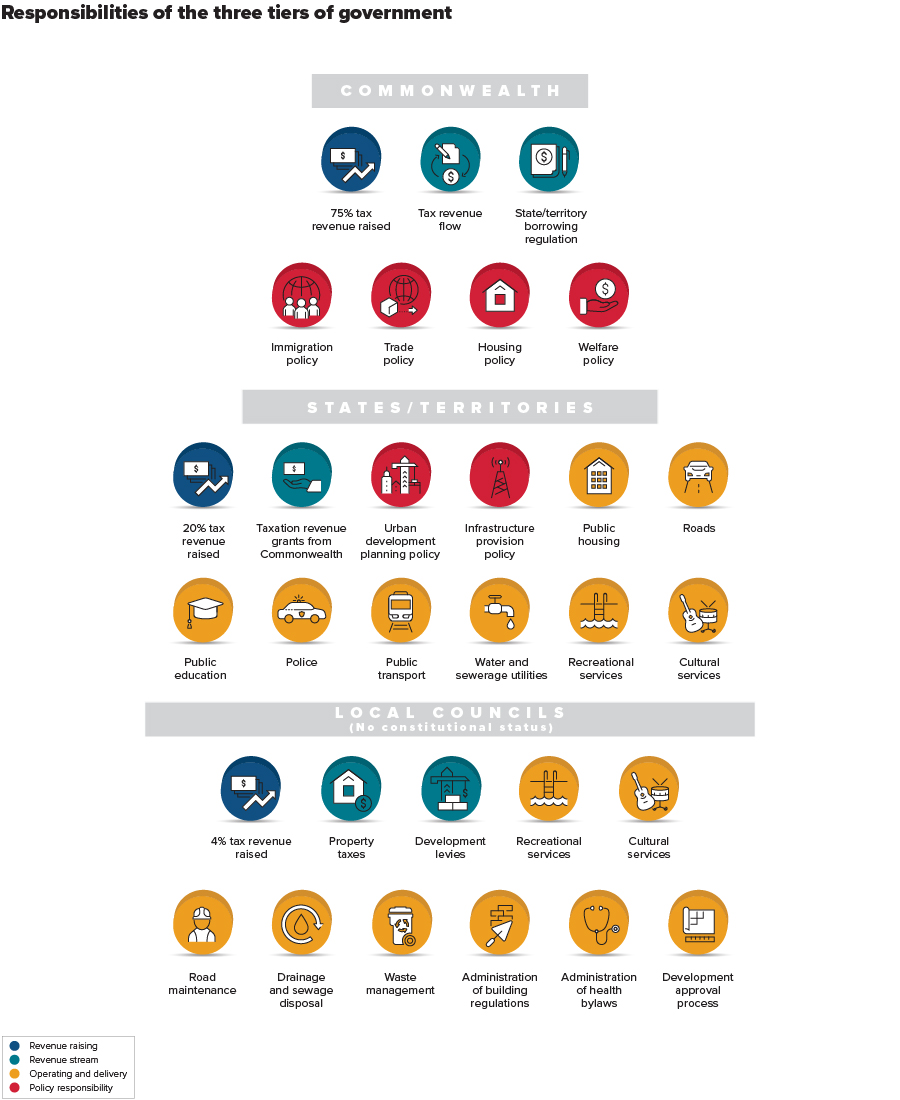This Brief addresses the urban governance arrangements for Australian cities, the role of long-term planning strategies and other regulation. The focus is on state and territory level strategies, current Federal government policies and infrastructure bodies.
Australia’s cities are subject to multiple levels of government, with responsibilities and roles divided between the federal, state or territory and local governments. Within those tiers of government, cities policies are spread between, and sometimes overlap across separate departments of planning, infrastructure, transport, housing and community services. The governance of Australia’s cities occurs across the three levels of government in collaboration with other non-government agencies.

Urban governance
At the local government level, arrangements vary between the different cities in Australia. For instance, the metropolitan region of Brisbane consists of only eight local government areas, amongst which Brisbane City Council, with over 1.1 million residents, is the largest local government in Australia. In contrast, the Perth metropolitan region spans 30 local government areas. Canberra is a special case, in that the city is governed directly by the Australian Capital Territory government and no councils exist.
The planning of Australia’s capital cities is primarily guided by metropolitan planning strategies authored by the planning department or directorate within the respective state or territory. State-level strategies outline a vision for the city, forecast future needs and provide strategic guidance for urban development. A key feature of all metropolitan planning strategies is setting a vision for the city and a range of objectives to achieve this. Research by AHURI has questioned the impact of metropolitan planning strategies on development decisions and housing outcomes. The evidence suggested that more specific planning provisions and clearer implementation mechanisms in policy frameworks would reduce uncertainty for the private sector, though potentially inhibit innovation and flexibility. The Greater Sydney Region Plan: A Metropolis of Three Cities calls for an integrated approach by coordinating land-use, transport and infrastructure planning across government agencies.
Infrastructure Australia argues that there is a need to establish a stronger role for the Federal Government to foster economic growth of cities by leveraging the opportunities and challenges of population growth. Infrastructure Australia has suggested that instead of focusing on the building and funding of infrastructure, the main role of governments should be to set the right conditions, including good planning, regulatory and market structures, to ensure the efficient delivery and use of infrastructure. The current Australian government is also involved in the development of cities through its City Deals which entail collaboration with the respective state and local government in a defined area. City Deals aim to achieve urban renewal by stimulating investments and driving reforms.
Research by AHURI is reviewing metropolitan governance arrangements and planning frameworks in Australia to identify spatial strategies and policy levers supporting their implementation. The implementation of objectives set within metropolitan planning strategies relies on planning departments working alongside other government agencies and the private sector.
The evidence (research by AHURI) suggested that more specific planning provisions and clearer implementation mechanisms in policy frameworks would reduce uncertainty for the private sector, though potentially inhibit innovation and flexibility.
Long-term planning strategies
Metropolitan planning strategies represent the main policy framework guiding urban interventions by state governments. These strategies provide a long-term outlook for the development of Australia’s cities. In South Australia the 30-Year Plan for Greater Adelaide focuses on the future of Adelaide over the next 30 years. Whereas, the Greater Sydney Region Plan: A Metropolis of Three Cities guides Sydney’s development to 2056 as a metropolitan region consisting of three main centres. Despite the intention of long-term strategic planning to cover a ten-to-forty-year horizon, metropolitan planning strategies are revised frequently. For instance, Melbourne’s metropolitan planning strategy, Plan Melbourne, was released in 2014, then refreshed in 2017 by a new government as Plan Melbourne 2017-2050. It replaced Melbourne 2030, released by the Victorian State Government in 2002 and updated in 2008 under the title Melbourne 2030: a planning update—Melbourne@5 million.
Similarly, infrastructure planning is guided by long-term plans, such as the 30-year strategy released by Infrastructure Victoria in 2016. Infrastructure Australia emphasises that a long-term view enables governments to better project changes in demand, identify emerging challenges and enact reforms and investments focusing on projects identified through the infrastructure priority list. To strengthen this approach the report recommends establishing a culture of infrastructure decision making guided by long-term planning. The infrastructure bodies, which work at ‘arms length’ from government, aim to encompass a broad view of Australia’s future infrastructure requirements which can withstand political cycles.
Planning intervention and regulation
Urban policies address the role of planning to intervene and regulate urban development through planning provisions and land-use zoning. Statutory planning is the responsibility of state and territory governments but is administrated by local governments. Policy reforms have been proposed in urban policies to reshape the planning system and its role in directing land use planning, urban development and housing.
Current research by AHURI is examining the impact of urban planning and regulation on emerging models for diverse housing supply. The research aims to identify strategies to support innovative housing structures and tenures.
The infrastructure bodies, which work at ‘arms length’ from government, aim to encompass a broad view of Australia’s future infrastructure requirements which can withstand political cycles.

